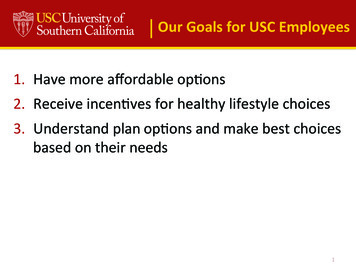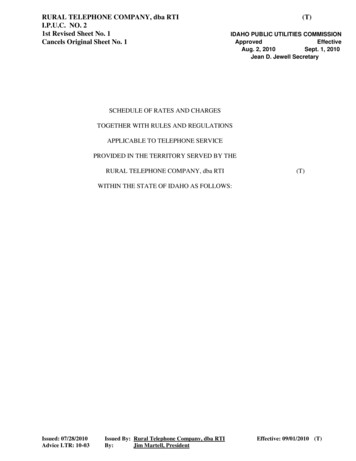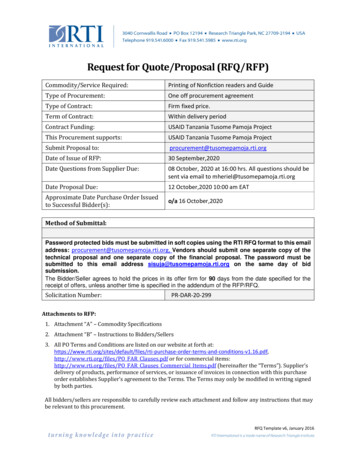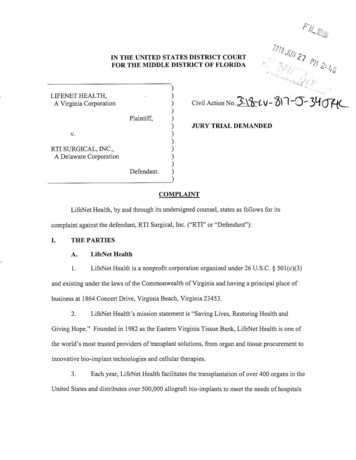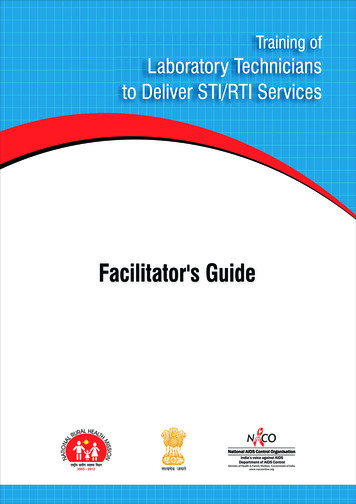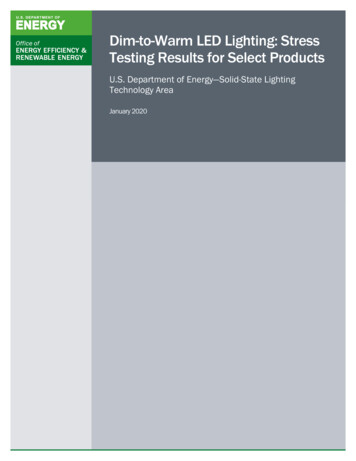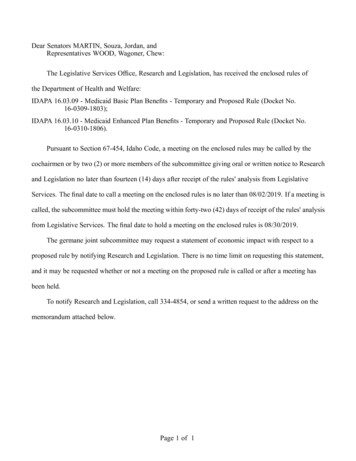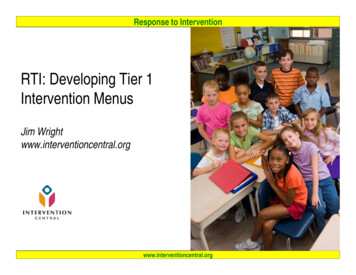
Transcription
Response to InterventionRTI: Developingp g Tier 1Intervention MenusJim entral.org
Response to InterventionRTI: Intervention Menus:Workshop AgendaRTI & Interventions: Overview & Definition ofTermsDocumenting Interventions at Tier 1Critical Components of Academic InterventionsSchoolwide Recommendations for ImplementingTi 1 IInterventionsTierttiPreparingp g Tier 1 Intervention Menu: PlanninggTimeWeb Resources for Tier 1 g
Response to InterventionRome City Schools Building Teams Bellamy Elementary School: Team 1D ti ElDentiElementaryt SSchool:h l TTeam 2Gansevoort Elementary School: Team 3Joy Elementary School: Team 4Ridge Mills Elementary School: Team 5Stokes Elementary School: Team 6Staley Upper Elementary School: Team 7Strough Middle School: Team 8Rome Free Academy: Team 9www.interventioncentral.org3
Response to Interventionwww.interventioncentral.org
Response to Interventionwww.interventioncentral.org
Response to Interventionwww.interventioncentral.org
Response to InterventionAcademic Interventions: KeyIdeaswww.interventioncentral.org
Response to InterventionCore Instruction, Interventions, Accommodations& Modifications:M difi tiSSortingti ThThem OOutt Core Instruction. Those instructional strategiesgthat are used routinely with all students in aggeneral-education settingg are considered ‘coreinstruction’. High-quality instruction is essentialand forms the foundation of RTI academicsupport. NOTE: While it is important to verify thatggood core instructional ppractices are in pplace fora struggling student, those routine practices donot ‘count’ as individual student interventions.www.interventioncentral.org8
Response to InterventionCore Instruction, Interventions, Accommodations& Modifications:M difi tiSSortingti ThThem OOutt Intervention. An academic intervention is astrategy used to teach a new skill, build fluencyin a skill, or encourageg a child to applypp y anexisting skill to new situations or settings. Anintervention can be thoughtg of as “a set ofactions that, when taken, have demonstratedabilityy to changeg a fixed educational trajectory”jy(Methe & Riley-Tillman, 2008; p. 37).www.interventioncentral.org9
Response to InterventionCore Instruction, Interventions, Accommodations& Modifications:M difi tiSSortingti ThThem OOutt Accommodation. An accommodation is intended to helpthe student to fully access and participate in the generalgeneraleducation curriculum without changing the instructionalcontent and without reducing the student’s rate of learning(Skinner Pappas & Davis,(Skinner,Da is 2005)2005). An accommodation isintended to remove barriers to learning while still expectingthat students will master the same instructional content asth i ttypicaltheiri l peers.– Accommodation example 1: Students are allowed to supplementsilent reading of a novel by listening to the book on tape.– Accommodation example 2: For unmotivated students, theinstructor breaks larger assignments into smaller ‘chunks’ andproviding students with performance feedback and praise for eachcompletedl t d ‘‘chunk’h k’ off assignedi d workk (Skinner,(SkiPPappas & DDavis,i2005).www.interventioncentral.org10
Response to Intervention““Teaching is giving; itisn’t taking away.””(Howell, Hosp & Kurns, 2008; p. 356).Source: Howell, K. W., Hosp, J. L., & Kurns, S. (2008). Best practices in curriculum-based evaluation. In A. Thomas & J.Grimes (Eds.), Best practices in school psychology V (pp.349-362). Bethesda, MD: National Association of SchoolPsychologists.www.interventioncentral.org11
Response to InterventionCore Instruction, Interventions, Accommodations &M difi tiModifications:S ti ThSortingThem OOutt Modification. A modification changes the expectations ofwhat a student is expected to know or do—typically bylowering the academic standards against which the studentis to be evaluated.e al atedExamples of modifications:– Giving a student five math computation problems for practiceinstead of the 20 problems assigned to the rest of the class– Letting the student consult course notes during a test when peersare not permitted to do sowww.interventioncentral.org12
Response to InterventionDefinitions: Activity Discuss the definitions of coreinstruction interventioninstruction,intervention, accommodationaccommodation, andmodification shared at this workshop. How might your building share these definitionswith your teachers? Howo mightg t you supposupportt youyour teacteacherse s to aavoidoduse of modifications for org13
Response to InterventionThe Key Role of ClassroomTeachers in RTI: 6 StepsJim entral.org
Response to InterventionRTI ‘Pyramid ofInterventions’Tier 3Tier 2Tier 1Tier 3: Intensive interventions.interventionsStudents who are ‘nonresponders’ to Tiers 1 & 2 arereferred to the RTI Team for moreintensive interventions.Tier 2 Individualizedinterventions. Subset ofstudents receive interventionstargeting specific needs.Tier 1: Universal interventions.interventionsAvailable to all students in aclassroom or school. Can consistof whole-group or individualstrategies or supports.www.interventioncentral.org15
Response to InterventionTier 1 Core InstructionTier I core instruction: Is universal—available to all students. Can be delivered within classrooms or throughoutgthe school. Is an ongoing process of developing strong classroom instructionalpractices to reach the largest number of struggling learners.All children have access to Tier 1 instruction/interventions. Teachers havethe capability to use those strategies without requiring outside assistance.Tier 1 instruction encompasses: The school’s core curriculum. Al published or teacher-made materials used to deliver that curriculum. Teacher use of ‘whole-group’ teaching & management strategies.Tier I instruction addresses this question: Are strong classroom instructionalstrategies sufficient to help the student to achieve academic success?www.interventioncentral.org16
Response to InterventionTier I (Classroom) InterventionTier 1 intervention: TTargetst ‘red‘ d flag’fl ’ studentst d t whoh are nott successfulf l withith coreinstruction alone. Uses ‘evidence-based’evidence based strategies to address student academicor behavioral concerns. Must be feasible to implement given the resources available inthe classroom.classroomTier I intervention addresses the question: Does the student makeadequate progress when the instructor uses specific academicor behavioral strategies matched to the presenting concern?www.interventioncentral.org17
Response to InterventionUse Time & Resources Efficiently By Collecting InformationO l on ‘ThiOnly‘Things ThThatt AAre AltAlterable’bl ’“ Time should be spentp thinkingg about thingsg that theintervention team can influence through instruction,consultation, related services, or adjustments to thestudent’st d t’ program. TheseThare thithings ththatt arealterable. Beware of statements about cognitiveprocesses that shift the focus from the curriculum andmay even encourage questionable educational practice.Theyy can also ppromote writingg off a student because ofthe rationale that the student’s insufficient performanceis due to a limited and fixed potential. “ p.359Source: Howell, K. W., Hosp, J. L., & Kurns, S. (2008). Best practices in curriculum-based evaluation. In A. Thomas & J.Grimes (Eds.), Best practices in school psychology V (pp.349-362). Bethesda, MD: National Association of SchoolPsychologists.www.interventioncentral.org18
Response to InterventionThe Key Role of Classroom Teachers in RTI:6 StepsSt1 The teacher defines the student academic or behavioral1.problem clearly.2. The teacher decides on the best explanation for why theproblem is occurring.3. The teacher selects ‘evidence-based’ interventions.4. The teacher documents the student’s Tier 1 intervention plan.5. The teacher monitors the student’sstudent s response (progress) to theintervention plan.p are when a student fails6. The teacher knows what the next stepsto make adequate progress with Tier 1 interventions alone.www.interventioncentral.org19
Response to InterventionThe Key Role of ClassroomTeachers in RTI 1. The teacher defines the student academic orbehavior problem in clear, specific, measurableterms.www.interventioncentral.org20
Response to InterventionDefining Academic or Behavioral ProblemsDescribe the student problem to provide a meaningfulinstructional context. The teacher is more likely to select aneffective intervention to help a struggling student if the studentproblem is first clearly defined and put into a meaningful context.This expanded definition includes information about the conditionsunderd whichhi h theh academicd i problembl iis observedbd andd typicali l orexpected level of performance.– Conditions. Describe the environmental conditions or task demands in placepwhen the academic problem is observed.– Problem Description. Describe the actual observable academic behavior inwhich the student is engaged.g g Include rate,, accuracy,y, or other qquantitativeinformation of student performance.– Typical or Expected Level of Performance. Provide a typical or expectedpperformance criterion for this skill or behavior. Typicalyp or expectedpacademicperformance can be calculated using a variety of sources,www.interventioncentral.org21
Response to Interventionwww.interventioncentral.org22
Response to InterventionThe Key Role of ClassroomTeachers in RTI 2. The teacher decides on the best explanation forwhat is causing the student problem.www.interventioncentral.org23
Response to InterventionBig Ideas: The Four Stages of Learning Can BeS mmed Up in the ‘InstructionalSummed‘Instr ctional Hierarchy’Hierarch ’(Haring et al., 1978)Student learning can be thought of as a multimulti-stagestage processprocess. Theuniversal stages of learning include: Acquisition: The student is just acquiring the skill. Fluency:FlTheTh studentt d t can performftheth skillkill bbuttmust make that skill ‘automatic’. Generalization: The student must pperform the skillacross situations or settings. Adaptation: The student confronts novel taskdemands that require that the student adapt acurrent skill to meet new requirements.Source: Haring, N.G., Lovitt, T.C., Eaton, M.D., & Hansen, C.L. (1978). The fourth R: Research in the classroom. Columbus,OH: Charles E. Merrill Publishing Co.www.interventioncentral.org24
Response to InterventionThe Key Role of ClassroomTeachers in RTI 3. The teacher selects one or more ‘evidencebased’ interventions to address the studentproblem.www.interventioncentral.org25
Response to InterventionA Sampling of Intervention Websites The What Works Clearinghouse has a series of free practiceguides that detail best recommended practices for promotingadolescent literacy, study and organizational skills and iceguides/www.interventioncentral.org26
Response to InterventionA Sampling of Intervention Websites Intervention Central has a collection of research-basedinterventions for academic and behavioral rventioncentral.org27
Response to InterventionThe Key Role of ClassroomTeachers in RTI 4. The teacher documents the student’s Tier 1(classroom) intervention plan.www.interventioncentral.org28
Response to InterventionInterventions: Potential ‘FatalFatal FlawsFlaws’1.2.3.4.Any intervention must include 4 essential elements. The absence of any one of theelements would be considered a ‘fatal flaw’ (Witt, VanDerHeyden & Gilbertson, 2004) thatblocks the school from drawing meaningful conclusions from the studentstudent’ss response to theintervention:Clearly defined problem. The student’s target concern is stated in specific, observable,measureable terms. This ‘problem identification statement’ is the most important step ofthe problem-solvingproblem solving model (Bergan,(Bergan 1995)1995), as a clearly defined problem allows the teacheror RTI Team to select a well-matched intervention to address it.Baseline data. The teacher or RTI Team measures the student’s academic skills in thetarget concern (e.g., reading fluency, math computation) prior to beginning the intervention.B li ddataBaselinet bbecomes ththe pointi t off comparisoniththroughouth t ththe iinterventiontti tto hhelpl ththeschool to determine whether that intervention is effective.Performance goal. The teacher or RTI Team sets a specific, data-based goal for studentpduringg the intervention and a checkpointpdate byy which the ggoal should beimprovementattained.Progress-monitoring plan. The teacher or RTI Team collects student data regularly todetermine whether the student is on-track to reach the performance goal.Source: Witt, J. C., VanDerHeyden, A. M., & Gilbertson, D. (2004). Troubleshooting behavioral interventions. A systematicprocess for finding and eliminating problems. School Psychology Review, 33, 363-383.www.interventioncentral.org29
Response to Interventionwww.interventioncentral.org30
Response to InterventionThe Key Role of ClassroomTeachers in RTI 5. The teacher monitors the students response(progress) to the intervention plan.www.interventioncentral.org31
Response to InterventionClassroom Methods of Data Collection Existing recordsGlobal skills checklistRating scalesBehavioral frequency countBehavioral loggStudent work samplesWork performance logsTimed assessments (e.g., tral.org
Response to InterventionExamplep of Classroom Progress-MonitoringggTool: Global Skills Checklists Description: The teacher selects a global skill.The teacher then breaks that global skill downinto specific, observable ‘subskills’. Each subskillcan be verified as ‘done’ or ‘not done’.www.interventioncentral.org33
Response to InterventionSkills Checklists: Example The teacher selects the global skill ‘organizationalskills’. That global skill is defined as having the followingcomponents, each of which can be observed: arriving to class on time; bringing work materials to class; following teacher directions in a timely manner; knowing how to request teacher assistance whenneeded; having an uncluttered desk with only essential workmaterials.www.interventioncentral.org34
Response to InterventionThe Key Role of ClassroomTeachers in RTI 6. The teacher knows what the next steps are whena student fails to make adequate progress withTier 1 interventions alone.www.interventioncentral.org35
Response to InterventionTier 1: Decision Rules The classroom teacher knows that Tier 1 (classroom)interventions alone are not sufficient for the struggling studentwhen:hThe student problem is clearly defined.Appropriate evidence-based interventions have been selectedthat match the student’s presenting concern(s).Th interventionThei tti planl hhas bbeen triedt i d ffor an adequatedt amountt offtime (e.g., 4-8 instructional weeks).St dent baseline performance is measStudentmeasured,red a goal is calccalculated,latedand progress-monitoring data is collected during the intervention.The student has not significantly closed the gap with peersdespite the classroom intervention plan.www.interventioncentral.org36
Response to InterventionDocumenting Tier 1 Interventions: ActivityReview these forms: Tier 1 intervention documentation form on pp. 27 Classroom progress-monitoring worksheet on p.49.49 Using these as models, discuss what yourschool’sschools forms should look for documentingTier 1interventions.www.interventioncentral.org37
Response to InterventionRome City Schools Building Teams Bellamy Elementary School: Team 1D ti ElDentiElementaryt SSchool:h l TTeam 2Gansevoort Elementary School: Team 3Joy Elementary School: Team 4Ridge Mills Elementary School: Team 5Stokes Elementary School: Team 6Staley Upper Elementary School: Team 7Strough Middle School: Team 8Rome Free Academy: Team 9www.interventioncentral.org38
Response to InterventionImproving the Integrity ofAcademic InterventionsThThroughhaCritical-Components ‘PreFlight’ CheckJim entral.org
Response to InterventionAcademic Interventions ‘Critical Components’ Checklistwww.interventioncentral.org40
Response to InterventionAcademic Interventions ‘Critical Components’ ChecklistThis checklist summarizes the essential components ofacademic interventions.interventions When preparing a student’sstudent sTier 1, 2, or 3 academic intervention plan, use thisdocument as a ‘pre-flightpre flight checklistchecklist’ to ensure that theacademic intervention is of high quality, is sufficientlystrong to address the identified student problem, is fullyunderstood and supported by the teacher, and can beimplemented with integrity. NOTE: While the checklistrefersf tot theth ‘t‘teacher’h ’ as ththe iinterventionist,tti i t it can alsolbe used as a guide to ensure the quality of interventionsimplemented by non-instructional personnelpersonnel, adultvolunteers, parents, and peer (student) tutors.www.interventioncentral.org41
Response to InterventionAllocating Sufficient Contact Time & Assuring Appropriate Student-TeacherRatioThe cumulative time set aside for an intervention and the amount of direct teacher contact are twofactors that help to determine that intervention’s ‘strength’ (Yeaton & Sechrest, 1981).Critical Item? Intervention ElementNotesTime Allocated. The time set aside for the intervention isappropriate for the type and level of student problem(Burns & Gibbons, 2008; Kratochwill, Clements &Kalymon, 2007). When evaluating whether the amount oftime allocated is adequate, consider: Length of each intervention session. Frequency of sessions (e(e.g.,g daily,daily 3 times per week) Duration of intervention period (e.g., 6 instructionalweeks)Student-Teacher Ratio.Ratio The student receives sufficientcontact from the teacher or other person delivering theintervention to make that intervention effective. NOTE:Generally, supplemental intervention groups should belimited to 6-7 students (Burns & Gibbons, 2008).www.interventioncentral.org
Response to InterventionMatching the Intervention to the Student ProblemAcademic interventions are not selected at random. First,, the student academic pproblem(s)( ) is definedclearly and in detail. Then, the likely explanations for the academic problem(s) are identified tounderstand which intervention(s) are likely to help—and which should be avoided.Critical Item? Intervention Element NotesProblem Definition. The student academic problem(s) to be addressed in theintervention are defined in clear, specific, measureable terms (Bergan, 1995;Witt, VanDerHeyden & Gilbertson, 2004). The full problem definition describes: Conditions. Describe the environmental conditions or task demands in placewhen the academic problem is observed. Problem Description.pDescribe the actual observable academic behavior inwhich the student is engaged. Include rate, accuracy, or other quantitativeinformation of student performance. Typical or Expected Level of Performance. Provide a typical or expectedperformance criterion for this skill or behavior. Typical or expected academicperformance can be calculated using a variety of sources,www.interventioncentral.org
Response to Interventionwww.interventioncentral.org44
Response to InterventionMatching the Intervention to the Student Problem (Cont.)Critical Item? Intervention ElementNotesAppropriate Target. Selected intervention(s) are appropriate for the identified studentproblem(s) (Burns, VanDerHeyden & Boice, 2008). TIP: Use the InstructionalHierarchy (Haring et al., 1978) to select academic interventions according to the fourstages of learning: Acquisition. The student has begun to learn how to complete the target skillcorrectly but is not yet accurate in the skill. Interventions should improveaccuracy. Fluency. The student is able to complete the target skill accurately but worksslowly. Interventions should increase the student’s speed of responding (fluency)as well as to maintain accuracy. Generalization.Generalization The student may have acquired the target skill but does nottypically use it in the full range of appropriate situations or settings. Or thestudent may confuse the target skill with ‘similar’ skills. Interventions should getthe student to use the skill in the widest possible range of settings and situations,or to accurately discriminate between the target skill and ‘similar’ skills. Adaptation. The student is not yet able to modify or adapt an existing skill to fitnovel task-demands or situations. Interventions should help the student toidentify key concepts or elements from previously learned skills that can beadapted to the new demands or situations.www.interventioncentral.org
Response to InterventionMatching the Intervention to the Student Problem (Cont.)Critical Item? Intervention Element Notes‘Can’t Do/Won’t Do’ Check. The teacher has determinedwhether the student problem is primarily a skill or knowledgedeficit (‘can’t do’) or whether student motivation plays amain or supporting role in academic underperformance(‘wont do’). If motivation appears to be a significant factorcontributing to the problem, the intervention plan includesstrategies to engage the student (e.g., high interest learningactivities; rewards/incentives; increased student choice inacademic assignments, etc.) (Skinner, Pappas & Davis,2005; Witt, VanDerHeyden & Gilbertson, 2004).www.interventioncentral.org
Response to InterventionActivity: Matching the Intervention to theSt d t ProblemStudentP bl Consider these critical aspects of academic intervention: Clear and specific problem-identification statement (Conditions, ProblemDescription, Typical/Expected Level of Performance). AAppropriatei t iinterventiontti ttargett ((e.g., selectedl t d interventioni tti iisappropriately matched to Acquisition, Fluency, Generalization, orAdaptationppphase of Instructional Hierarchy).y) Can’t Do/Won’t Do Check (Clarification of whether motivation plays asignificant role in student academic underperformance). What questions do you have about applying any of theseconceptsp when pplanningg classroom interventions?www.interventioncentral.org
Response to InterventionRome City Schools Building Teams Bellamy Elementary School: Team 1D ti ElDentiElementaryt SSchool:h l TTeam 2Gansevoort Elementary School: Team 3Joy Elementary School: Team 4Ridge Mills Elementary School: Team 5Stokes Elementary School: Team 6Staley Upper Elementary School: Team 7Strough Middle School: Team 8Rome Free Academy: Team 9www.interventioncentral.org48
Responseto InterventionIncorporating Effective InstructionalElementsThese effective ‘building blocks’ of instruction are well-known and well-supported by the research. Theyshould be considered when selectingg or creatingg anyy academic intervention.Critical Item? Intervention Element Explicit Instruction. Student skills have been broken down “into manageable and deliberatelysequenced steps” and the teacher provided“ overt strategies for students to learn and practicenew skills” (Burns, VanDerHeyden & Boice, 2008, p.1153). Appropriate Level of Challenge. The student experienced sufficient success in the academictask(s) to shape learning in the desired direction as well as to maintain student motivation(Burns, VanDerHeyden & Boice, 2008). Active Engagement. The intervention ensures that the student is engaged in ‘active accurateresponding’pg ((Skinner,, Pappaspp & Davis,, 2005).at) a rate frequentqenoughg to capturepstudentattention and to optimize effective learning. Performance Feedback. The student receives prompt performance feedback about the workcompleted (Burns, VanDerHeyden & Boice, 2008). Maintenance of Academic Standards. If the intervention includes any accommodations tobetter support the struggling learner (e.g., preferential seating, breaking a longer assignment intosmaller chunks), those accommodations do not substantially lower the academic standardsagainst which the student is to be evaluated and are not likely to reduce the studentstudent’ss rate oflearning (Skinner, Pappas & Davis, 2005).www.interventioncentral.orgNotes
Response to InterventionActivity: Incorporating Effective InstructionalElElementst Think about the effectiveinstructional elements reviewedin this workshop. Incorporating Effective InstructionalHow can teachers ensure that Elementsall effective instructionalelements are included inacademic interventions?CriticalItem? www.interventioncentral.orgIntervention ElementExplicit Instruction.gAppropriate Level of Challenge.Active Engagement.Performance Feedback.Maintenance of AcademicSt d dStandards.Notes
Response to InterventionVerifying Teacher Understanding & Providing Teacher SupportThe teacher is an active agent in the intervention, with primary responsibility for putting it into practice in abusy classroom. It is important, then, that the teacher fully understands how to do the intervention, believesthat he or she can do it, and knows whom to seek out if there are problems with the intervention.Critical Item? Intervention ElementNotesTeacher Responsibility. The teacher understands his or her responsibility to implement theacademic intervention(s) with integrity.Teacher Acceptability. The teacher states that he or she finds the academic intervention feasibleand acceptable for the identified student problem.problemStep-by-Step Intervention Script. The essential steps of the intervention are written as an‘intervention script’--a series of clearly described steps—to ensure teacher understanding andmake implementation easier (Hawkins, Morrison, Musti-Rao & Hawkins, 2008).Intervention Training. If the teacher requires training to carry out the intervention, that traininghas been arranged.Intervention Elements: Negotiable vs. Non-Negotiable. The teacher knows all of the steps ofthe interventionintervention. AdditionallyAdditionally, the teacher knows which of the intervention steps are ‘non-negotiable’non-negotiable(they must be completed exactly as designed) and which are ‘negotiable’ (the teacher has somelatitude in how to carry out those steps) (Hawkins, Morrison, Musti-Rao & Hawkins, 2008).Assistance With the Intervention. If the intervention cannot be implemented as designed for anyreason (e.g., student absence, lack of materials, etc.), the teacher knows how to get assistancequickly to either fix the problem(s) to the current intervention or to change the intervention.www.interventioncentral.org
Response to InterventionActivity: Verifying Teacher Understanding &P idi TeacherProvidingT h SupportStIn your teams: Review the checklist for verifying that teachersunderstand all elements of the interventionand actively support its use.Verifyingy g Teacher Understandingg & How will your school ensureProviding Teacher Supportthat teachers willCritical Item?Intervention Elementunderstand and supportpppy Teacher Responsibility Teacher Acceptability.academic interventions Step-by-Step Intervention Script.designed to be implemented in Intervention Training. I tInterventionti Elements:Elt NegotiableN ti blth classroom?thel?vs. Non-Negotiable www.interventioncentral.orgAssistance With the Intervention
to InterventionDocumenting the InterventionResponse& CollectingDataInterventions only have meaning if they are done within a larger data-based context. For example,interventions that lack baseline data, goal(s) for improvement, and a progressprogress-monitoringmonitoring plan are ‘fatallyfatallyflawed’ (Witt, VanDerHeyden & Gilbertson, 2004).Critical Item?Intervention ElementNotes Intervention Documentation. The teacher understands and can manage all documentationrequired for this intervention (e.g., maintaining a log of intervention sessions, etc.). Checkup Date. Before the intervention begins, a future checkup date is selected to review theintervention to determine if it is successful. Time elapsing between the start of the intervention andthe checkup date should be short enough to allow a timely review of the intervention but longenough to give the school sufficient time to judge with confidence whether the intervention worked. Baseline. Before the intervention begins, the teacher has collected information about the student’sb li llevell off performancebaselinefini ththe ididentifiedtifi d area(s)( ) off academicd i concern (Witt(Witt, VVanDerHeydenD H d &Gilbertson, 2004). Goal. Before the intervention begins, the teacher has set a specific goal for predicted studentimprovement to use as a minimum standard for success (Witt,(Witt VanDerHeyden & Gilbertson,Gilbertson 2004)2004).The goal is the expected student outcome by the checkup date if the intervention is successful. Progress-Monitoring. During the intervention, the teacher collects progress-monitoring data ofsufficient quality and at a sufficient frequency to determine at the checkup date whether thatintervention is successful (Witt, VanDerHeyden & Gilbertson, 2004).www.interventioncentral.org
Response to InterventionActivity: Documenting the Intervention &C ll ti DCollectingDatatIn your teams: Consider the elements of interventiondocumentation,, data collection,, and datainterpretation discussed here. Documenting the Intervention &What steps can your school take Collecting Datato make sure that data have acentral focus when interventionsare planned and implemented?Critical Item?Intervention Element Intervention Documentation.Checkup Date. Baseline. Goal. es
Response to InterventionReferences Bergan, J. R. (1995). Evolution of a problem-solving model of consulta
Rome City Schools Building Teams Bellamy Elementary School: Team 1 l E iDtt S Th l 2Denti Elementary School: Team 2 Gansevoort Elementary School: Team 3 Joy Elementary School: Team 4 Ridge Mills Elementary School: Team 5 Stokes Elementary School: Team 6 Staley Up
